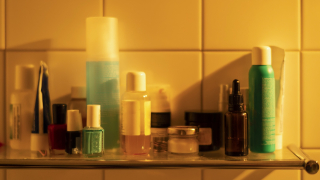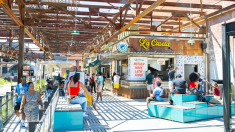I’m what you call a 'retronaut.' I am actually one of those people who wishes that I could go back in time, back to when life was simpler, illuminated only by candlelight, ruled by kings, queens, surrounded by castles, churches and beautiful architecture. This is one of several reasons why I love Europe so much.
On my first vacation of the summer, we were looking for a new, yet remote-ish vacation spot, when my friends, Alvaro and Pedro saw an article about a seemingly fabulous restaurant built into a cave overlooking the Adriatic Sea. Wowed by the scenery and impressed by the reviews, the impetus for our vacation was born. We scoured the Internet for information about the region, hotels and sights and began planning what turned out to be the trip of a lifetime. The more I researched, the more excited I became and with good reason. Puglia has it all, except an overabundance of tourists and couldn’t be more dissimilar from its more famous neighbors to the north.
I’d been to Italy more times than I can count, and even lived there for a short time, but I’d never given two thoughts about visiting the little known region of Puglia, located in the heel of Italy’s boot. Puglia is undeniably gorgeous; it boasts 500 miles of pristine coastline, the longest in Italy and rests between the shores of the Adriatic Sea on the East and Ionian Sea on the West. Its shores boast some of the clearest and most pristine beaches in the world. The region is dotted with olive groves and produces most of the Italian extra virgin olive oil and some of the world’s best tomatoes, hands down. Wine aficionados need not feel left out—vineyards and wineries abound! Puglia’s modern towns remain heavily influenced by their Greek and Byzantine roots, and when converged with traditional Italy, you often forget you are in present day.
I flew into Bari, a rather industrial city, probably most famous for the Bascilica of St. Nicholas (as in Father Christmas). I met my 2 friends, a very well traveled couple from Rio, who scooped me at the airport with wide smiles and a boxy Ford suitable to haul our bags around the province. We loaded the car, headed south to the city of Monopoli and explored the city’s famous narrow walkways and churches, all of which were post card worthy. After a brief stroll around the town and the beach, I was ready to accomplish what I came here for: great Puglian food and lots of wine.
For our first meal, we headed to Ristorante Masseria Spina, located in a 16th century fort tucked off a narrow road near Monopoli. We drove down a long gravel driveway to an imposing tower, surrounded by a moat and a courtyard. Walking into this former fort-turned-farmhouse, it is evident that the proprietors took painstaking measures to preserve the history while appealing to the discerning tastes of 21st century patrons. The dining area, the farmhouse’s converted stable, was washed in rich limestone hues and the executive chef, Angelo carefully yet traditionally prepared each dish. We dug in like it was the Last Supper: we gorged ourselves on fava bean puree, topped with fresh oysters, several appetizers, one topped with horse meat (no thank you, but Pedro and Alvaro indulged wholeheartedly) and a codfish in tomato water so tasty yet surprisingly simple, I convinced myself that I could recreate this at home (note: not surprisingly, I could not).
The next night, we headed to Ristorante Grotta Palazzese, the cliffside restaurant that was impetus of our trip. We descended down a steep spiral staircase to the restaurant located in a cave carved by nature out of limestone rocks suspended 74 feet above the Adriatic. The restaurant is elegantly lit by candlelight with diners on one side overlooking the crashing waves of the Adriatic while diners on the other are lulled by the calm of the blueish green waters in the grotto. We quickly decided on the chef’s fish tasting menu: calamari filled with ricotta cream, pasta with rockfish ragu, and our main course was a perfectly prepared local white fish. No Italian dinner, especially ours, would be complete without at least a few bottles of regional white wine. After dinner, I serenely felt if I inadvertently fell off the restaurant’s cliff right then, my life, at that moment, would have been complete!
Fortunately, I did not take that tumble, so the next day, we made our way to the small town of Alberobello, and it was there that I really got my time travel on. This tiny town is like stepping back in time, a perfectly genial, well preserved village lined with narrow, blonde cobblestone streets sprinkled with Trulli houses. Trulli, traditional Puglian houses constructed with thick stone walls and conical roofs, look strikingly similar to white dollhouses. In Old Town Alberobello, you see the old juxtaposed perfectly with the new: proprietors of souvenir shops housed in one trulli rubbing elbows with a next door neighbor, crafting rugs with a loom straight out of the 18th century. The lifestyle here is a throwback of a simpler time, and I thought, if I could only weave rugs, that I would have taken up residence.
We managed to visit only one winery, but as they say, “If you do it right, once is enough.” We struck gold when we visited Vini Minhir, a winery housed in a former convent, located in one of the oldest buildings in Otranto. We ate by candlelight in the courtyard from the tasting menu Eggplant Parm, Pea Puree, Ricotta Balls and Tagliolini with tomato, accompanied by red, white, rose and dessert wines. We visited on a Sunday night, and had the restaurant mainly to ourselves (although I did share some of my delicious food with the house cat, Nina). The sommelier, Cosimo carefully explained the notes, grapes and other aspects of the wine, while I sucked down each glass of wine like a pro. Afterwards Cosimo took me on private tour of the winery, nostalgia front and center when I saw where the nuns actually once pressed wine with their feet (think “I Love Lucy”). If you are looking for a great meal and wine tasting, you can’t miss this gem.
We visited a few other towns up and down both coasts: Lecce and Gallipoli, each gorgeous and worth a trip on their own. But the crown jewel was undeniably visiting Matera, the Town of Stone. Matera dates back to the Paleolithic time, and is the second oldest human settlement on Earth. Coming here is like stepping back into Jesus’ time, complete with donkeys and stassi (mountainside caves) carved into stone, exactly like the cave where Jesus was buried. I was amazed by the fact that families lived in the stassi, along with their farm animals from the Stone Age until the mid 1950s, when the government relocated these families to more traditional (yet a form of cave) housing. Matera looks much like Jerusalem and has been used as a set for filming many films biblical films, including Mel Gibson’s The Passion of the Christ. We stayed in Sextantio Le Grotte, a cave hotel (apparently, Pedro and I have a thing for caves) carved into the side of a mountain. This hotel was like none other that I’d seen. The proprietors meticulously deconstructed and reconstructed the hotel stone by stone to add the modern amenities to the cave “rooms” such as heat and light. I did feel remarkably like Wilma Flintstone meets Judy Jetson as I stepped into my bathtub in the middle of my cave room (not bathroom), blaring tunes from my IPhone and Jambox speakers. Later, as we ambled around the town taking photos, I managed to drag my friends to visit 13th century churches and a replica of the Stassi from way back when. Of course, we celebrated the impending end to our trip with food and wine, in where else? A cave restaurant.
The next day, I loaded up all of my wine (and the very few new shoes I’d bought) and mentally filed away the beautiful memories from my trip. Fighting the nostalgia on the way to the airport, heading home the words of Emerson filled my head: “Though we travel the world over to find the beautiful, we must carry it with us or we find it not.”
Lisa Bonner is an entertainment lawyer in New York City. Follow her on Twitter: @lisabonner













